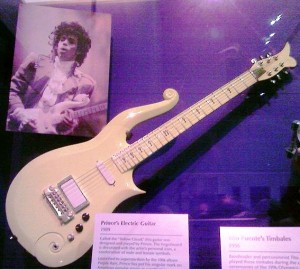Any serious discussion about the most accomplished musicians of the past 25 or 30 years has to include one name: Prince. The diminutive singer/songwriter/guitarist has been many things: controversial, mercurial, off-putting, but no one can deny the guy’s talent.
Born Prince Rogers Nelson in 1958, the Minneapolis native immersed himself in bands like Santana and Sly & the Family Stone from an early age. He quickly picked up the piano and guitar, as well as just about every other instrument in existence. At just 19 years of age, he signed a contract with Warner Brothers Records that allowed him to produce his own material. At the time, he was the youngest artist afforded such a contract. 1978’s For You announced the arrival of a major talent on the scene, and-as the album credits meticulously stated-all instruments were written, produced and performed by Prince.
Prince then began a breakneck schedule of recording and touring that saw him release an album every year in the Eighties except for 1983. He achieved his first major success with the platinum self-titled album of 1979 and his first Top 40 pop hit, I Wanna Be Your Lover (#11). However, he didn’t become a critical darling until the following year’s Dirty Mind. Titillating listeners with his new-wave spiked soul tunes and creamy falsetto, he got as much attention for the risqué lyrics (which included allusions to pornography, incest and oral sex) as for his wardrobe, which usually consisted of a trenchcoat, high heels and bikini underwear.
By 1982’s 1999, his wardrobe had grown slightly more conservative, and although the music was still forward-thinking, it brought his first major pop success with the Top Ten hits, Little Red Corvette” and Delirious. Prince became powerful enough to get a film green lit. That flm, 1984’s Purple Rain, became a surprise blockbuster, grossing $90 million while the album sold upwards of 10 million copies. Prince had arrived as a megastar, the only artists as big or bigger than him at the time were Bruce Springsteen and Michael Jackson, with whom he enjoyed an on-again, off-again rivalry.
Although his album sales slid in the wake of Purple Rain, Prince continued churning out interesting albums like 1985’s Around the World in a Day and 1986’s Parade. The latter album was the soundtrack to Prince’s second movie Under the Cherry Moon, a film that flopped almost as soundly as Purple Rain had soared.
Looking for a change, Prince fired his backing band, The Revolution, and went on to record his masterpiece. 1987’s Sign o’ the Times was an experimental 2-disc masterpiece, winning many Album of the Year polls (and losing the AOTY Grammy to U2’s The Joshua Tree). Most consider it the best album of Prince’s career, with a few calling it the best album of the entire decade. However, the magic seemed to leave Prince just as quickly. Follow-up album Lovesexy was the lowest-selling Prince album since his debut (partially due to Prince posing nude on the album cover-a move that got him banned from a few major retail chains). He rebounded commercially with the soundtrack to the first Batman film, but his own celluloid follow-up was a disaster. 1990’s Graffiti Bridge, which found Prince reprising his Purple Rain character, effectively ended his film career.
Prince again rebounded with 1991’s Diamonds & Pearls and 1992’s Love Symbol album (both recorded with new backing band the New Power Generation), but confounded many in 1993 when he changed his name to the unpronounceable symbol he’d titled his 1992 album with. Many saw the move as a sign that Prince had finally lost it, but Prince reportedly saw the move as a way to dissolve the contentious relationship he had with Warner Brothers Records. In the three years between his name change and the end of his Warner tenure, an army of albums were released, both under Prince’s name and under the symbol (with many referring to him as “The Artist Formerly Known as Prince” or simply “The Artist”).
Prince ceremoniously ended his relationship with Warner in 1996, quickly signing with EMI and releasing 1996’s triple-disc set Emancipation. The album sold well, being certified double platinum, but not up to the level Prince records sold in his heyday. He also suffered a series of personal triumphs, like his marriage to former backup dancer Mayte Garcia, and setbacks, like the loss of the baby Mayte had shortly after his birth.
The next few years found Prince bouncing between releasing titles independently, releasing music through the internet (Prince was arguably the first major artist to realize the power of the ‘net), and having the occasional dalliance with major labels. He also became Prince again, changing back to his birth name in 1999.
2004 brought yet another major Prince comeback. On the heels of a triumphant Grammy performance with Beyonce and his induction into the Rock & Roll Hall of Fame, the Musicology tour became one of the year’s most successful, and the attendant album became his biggest seller in thirteen years (although it caused controversy when it was revealed that copies of the album were factored in to the ticket price and registered with Soundscan, keeping the album in the upper reaches of the Billboard chart throughout the summer). Formerly one of the most controversial artists of his time, Prince at this point had mellowed out considerably, becoming a follower of the Jehovah’s Witness faith.
2006’s 3121 became the first album of Prince’s career to enter the charts at #1, and the following year’s Planet Earth featured a reunion with longtime sidewomen Wendy & Lisa. Prince, to date, still receives a mixture of awe (his performance at 2007’s Super Bowl was given a rapturous reception) and derision (the same performance was criticized for featuring phallic imagery and references to masturbation when Prince was shown in shadow playing his “love symbol” shaped guitar) to outright confusion (Prince steadfastly goes after sites like You Tube that post music and videos of his without paying him, and he’s even shut down fan sites for doing the same).
In addition to his exploits as a performer, Prince has maintained a career as a producer and songwriter. Not only has he launched a series of protégés, ranging from The Time & Vanity 6 to future actress/model Carmen Electra, but he has written and produced for Patti LaBelle, Sinead O’ Connor, Celine Dion, Kenny Rogers, Madonna, George Clinton, Tevin Campbell, Stevie Nicks, Chaka Khan and many others.
Love him or hate him, the little man from Minneapolis has made an indelible imprint on music that is still evident whenever you turn on a radio today.
Prince Reviews on Pop Rock Nation
Around The World In A Day – Prince’s most underrated album
Photo credit: ejk at flickr

